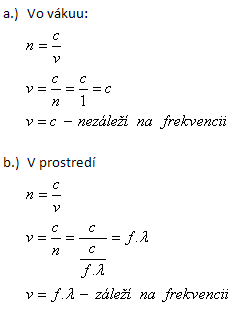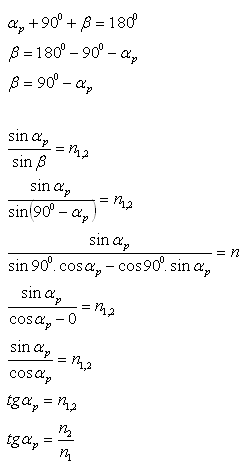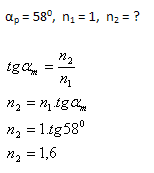Dispersion and polarization of light
1. Explain the dispersion and polarization of light.
Solution:
Decomposition of Light
White light is a mixture of seven monochromatic colors (red, orange, yellow, green, blue, indigo, violet), i.e., a mixture of electromagnetic waves with different frequencies.
| R |
O |
Y |
G |
B |
I |
V |
| f (10¹⁴ Hz) |
4.6 |
5.0 |
5.2 |
5.75 |
6.7 |
7.0 |
Individual colored lights propagate in a medium at different speeds v<c,
therefore they have different refractive indices and refract at different angles.
n=λλ0=λfcc=λfc v=nc=λfcc=λf
Polarization of Light
Natural light is unpolarized. It is a transverse electromagnetic wave, characterized by oscillations of mutually perpendicular vectors
E⊥B⊥v. On the retina of the eye, only the oscillations of the vector of electric field intensity E act.
In polarized light, the oscillation of vector E occurs in one plane.
Complete polarization occurs when the angle of incidence is the so-called Brewster’s angle αp.
tanαp=n1n2
At the polarization angle αp, the reflected ray is perpendicular to the refracted ray.
2.The wavelength of the hydrogen line H2 in air is λ0 = 656.4nm. What is its wavelength in water? (n = 1.33)
Solution:
Analysis:

The wavelength of the hydrogen line H2 in water is λ = 493.5nm.
3. Determine whether the speed at which light propagates depends on its frequency
Solution:

In vacuum, the speed of light does not depend on frequency, in a medium it does.
4. Derive the formula for calculating Brewster's angle – the angle of complete polarization.
Solution:
At the polarization angle αp, the reflected beam is perpendicular to the refracted beam.

The formula for calculating Brewster's angle is tgαp = n1,2
5. The angle of complete polarization for opaque enamel is αp = 58°. What is the refractive index of the enamel? (n1=1,n2=?)
Solution:
Analysis:

The refractive index of enamel is n2 = 1.6
6. Calculate Brewster's angle of complete polarization for:
- water: n = 1.33
- glass: n = 1.5
- diamond: n = 2.465
Solution:

Brewster's angle of complete polarization is for water 530, glass 56.30 and diamond 680.